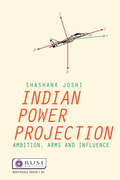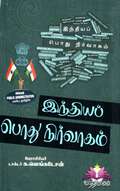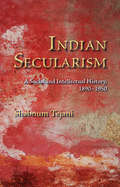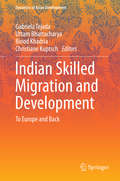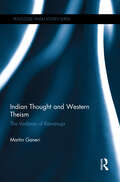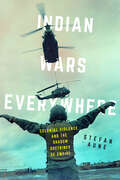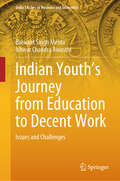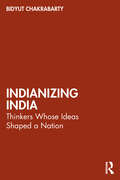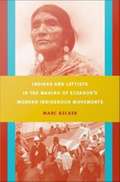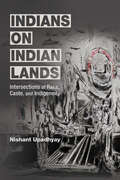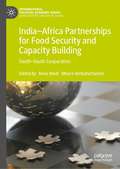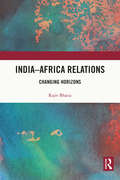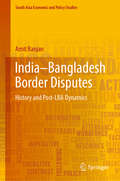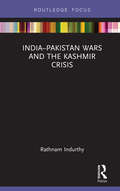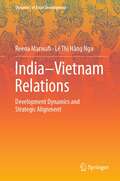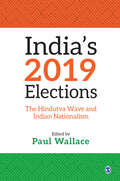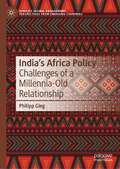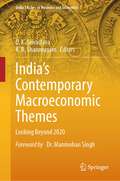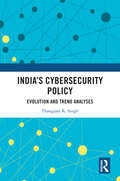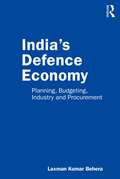- Table View
- List View
Indian Power Projection: Ambition, Arms and Influence (Whitehall Papers)
by Shashank JoshiIndia is growing into one of Asia’s most important military powers. Its defence budget has more than doubled in the past decade, and it imports more arms than anyone else in the world. But India is still seen as a land power focused on long, disputed and militarised borders with Pakistan and China rather than the global military force it was in the first half of the twentieth century under British rule. Is this changing? India is acquiring increasing numbers of key platforms – aircraft carriers, amphibious ships, refuelling tankers and transport aircraft – that are extending its reach to the Indian Ocean littoral and beyond. But most accounts of this build-up have been impressionistic and partial. Indian Power Projection assesses the strength, reach and purposes of India's maturing capabilities. It offers a systematic assessment of India’s ability to conduct long-range airstrikes from land and sea, transport and convey airborne and amphibious forces, and develop the institutional and material enablers that turn platforms into capabilities. It draws extensively on the lessons of modern expeditionary operations, and considers how India’s growing interests might shape where and how it uses these evolving capabilities in the future. This study finds that Indian power projection is in a nascent stage: limited in number, primarily of use against much-weaker adversaries, and deficient in some key supporting capabilities. India’s defence posture will continue to be shaped by local threats, rather than distant interests. Indian leaders remain uncomfortable with talk of military intervention and expeditionary warfare, associating these with colonial and superpower excess. But as the country’s power, interests and capabilities all grow, it is likely that India will once more find itself using military force beyond its land borders.
Indian Public Administration: இந்திய பொது நிர்வாகம்
by Professor Dr. K. Venkatesanஇந்த நூல், நிரலாக்க நிரலாக்கத்தின் முழுவதிலும் அவசரமாகப் பரிசோதித்த ஒரு வழிகாட்டி. நிர்வாக என்பது முழுவதும் உதாரணங்களையும் அல்லது கட்டாயமாகப் உதவும் அனைத்து பரிசோதனைகளையும் சேர்ந்து அநுகரிக்கும். நிர்வாக அமைப்பின் பிரிவுகளையும், விளக்கமான புரிந்து கொள்ள பயனுள்ள உணர்வையும் கொண்டுகொள்ளும் வழிகாட்டிக் கொள்ளுகின்றது. நிர்வாகத்தின் பொருளாதாரங்களின் உருவாக்கத்தை அல்லது அதன் தரவுத்தாளை விளக்கப்படுத்தலில், அநிரந்தரமான அனுபாதங்களைக் குறித்து விளக்கமான அறிந்துகொள்ளும் வழிகாட்டியாக இந்த நூல் அமைந்துள்ளது.
Indian Secularism: A Social and Intellectual History, 1890-1950
by Shabnum TejaniMany of the central issues in modern Indian politics have long been understood in terms of an opposition between ideologies of secularism and communalism. Observers have argued that recent Hindu nationalism is the symptom of a crisis of Indian secularism and have blamed this on a resurgence of religion or communalism. Shabnum Tejani unpacks prevailing assumptions about the meaning of secularism in contemporary politics, focusing on India but with many points of comparison elsewhere in the world. She questions the simple dichotomy between secularism and communalism that has been used in scholarly study and political discourse. Tracing the social, political, and intellectual genealogies of the concepts of secularism and communalism from the late nineteenth century until the ratification of the Indian constitution in 1950, she shows how secularism came to be bound up with ideas about nationalism and national identity.
Indian Skilled Migration and Development
by Christiane Kuptsch Gabriela Tejada Uttam Bhattacharya Binod KhadriaThis edited contribution explores strategies and measures for leveraging the potential of skilled diasporas and for advancing knowledge-based evidence on return skilled migration and its impact on development. By taking the example of Indian skilled migration, this study identifies ways of involving returned skilled migrants in home country development as well as proposes approaches to engage the diaspora in development. As high-skill immigration from India to mainland Europe is a rather recent phenomenon, the activities of Indian professionals in Europe are under-researched. The findings have wider application in contributing to the policy dialogue on migration and development, specifically to the advantage for developing and emerging economies. The book employs an interdisciplinary, two-fold approach: The first part of the research looks at how international exposure affects the current situation of skilled returnees in India. The second, European, part of the research examines migration policies, labour market regulations and other institutional settings that enable or hinder skilled Indians' links with the country of origin. Structural differences between the host countries may facilitate different levels of learning opportunities; thus, this book identifies good practices to promote the involvement of Indian skilled diaspora in socio-economic development. In applying the framework of diaspora contributions as well as the return channel to study the impact on India, the book draws on qualitative and quantitative research methods consisting of policy analysis, in-depth interviews with key experts and skilled migrants and on data sets collected specifically for this study.
Indian Thought and Western Theism: The Vedānta of Rāmānuja (Routledge Hindu Studies Series)
by Martin GaneriThe encounter between the West and India in the modern period has also been an encounter between Western modernity and the traditions of classical Indian thought. This book is the study of one aspect this encounter, that between Western scholasticism and one classical Indian tradition of religious thought and practice: the Vedānta. In the modern period there have been many attempts to relate Western theistic traditions to classical Indian accounts of ultimate reality and the world. Parallels have usually been drawn with modern forms of Western philosophy or modern trends in theism. Modern Indological studies have continued to make substantial use of Western terms and concepts to describe and analyse Indian thought. A much-neglected area of study has been the relationship between Western scholastic theology and classical Indian thought. This book challenges existing parallels with modern philosophy of religion and forms of theism. It argues instead that there is an affinity between scholasticism and classical Indian traditions. It considers the thought of Rāmānuja (traditional dates 1017-1137 CE), who developed an influential theist and realist form of Vedānta, and considers how this relates to that of the most influential of Western scholastics, Thomas Aquinas (1224/5-1274 CE). Within what remain very different traditions we can see similar methods of enquiry, as well as common questions and concerns in their accounts of ultimate reality and of the world. Arguing that there is indeed an affinity between the Western scholastic tradition and that of classical Indian thought, and suggesting a reversal of the tendencies of earlier interpretations, this book will be of interest to students and scholars of Asian religion, Hinduism and Indian philosophy.
Indian Wars Everywhere: Colonial Violence and the Shadow Doctrines of Empire (American Crossroads #71)
by Stefan AuneReferences to the Indian Wars, those conflicts that accompanied US continental expansion, suffuse American military history. From Black Hawk helicopters to the exclamation "Geronimo" used by paratroopers jumping from airplanes, words and images referring to Indians have been indelibly linked with warfare. In Indian Wars Everywhere, Stefan Aune shows how these resonances signal a deeper history, one in which the Indian Wars function as a shadow doctrine that influences US military violence. The United States’ formative acts of colonial violence persist in the actions, imaginations, and stories that have facilitated the spread of American empire, from the "savage wars" of the nineteenth century to the counterinsurgencies of the Global War on Terror. Ranging across centuries and continents, Indian Wars Everywhere considers what it means for the conquest of Native peoples to be deemed a success that can be used as a blueprint for modern warfare.
Indian Youth and Electoral Politics
by Sanjay KumarIndian Youth and Electoral Politics studies the significant relationship between Indian youth and electoral politics in the country. The book answers many pertinent questions: Does a young candidate matter to the young voters? Do youth vote more enthusiastically if there are young candidates contesting elections? Contrary to popular notions, there is an increased interest in electoral politics amongst the Indian youth. But when it comes to voting, there is a lower participation. The book looks at the level of awareness of the youth about political issues and analyzes youth interest and participation in electoral politics. It also points out that a large percentage of Indian youth would be willing to take up politics as their career choice. However there are differences in level of youth interest and electoral participation along gender, locality, and various such social variables.
Indian Youth’s Journey from Education to Decent Work: Issues and Challenges (India Studies in Business and Economics)
by Balwant Singh Mehta Ishwar Chandra AwasthiThis book delves into the intricate challenges faced by Indian youth as they enter the labour market. It explores vital aspects of youth's journey from school to the labour market, offering insights into the current status and strategies for harnessing the demographic dividend, bridging the gap between labour market demand and supply, addressing the issue of skill mismatch, and tackling the challenge of inactive or idle youth in India. The book draws from analysing a diverse range of data sources, including statistics from organizations like the International Labour Organization (ILO) and the World Bank&’s World Development Indicators (WDI); as well as data from surveys such as Periodic Labour Force Survey (PLFS) and Employment-Unemployment Survey (EUS), conducted by the National Sample Survey Office (NSSO) of the Ministry of Statistics and Programme Implementation (MoSPI), Government of India; and educational surveys such as Unified District Information System for Education (UDISE), All India Survey on Higher Education (AISHE), School Education Quality Index (SEQI) and NSSO's surveys on Household Social Consumption: Education. These data cover a period spanning of over two decades, from 2000 to 2023. The book is a valuable resource for policymakers, researchers, and anyone interested in understanding the complex challenges and opportunities associated with the transition of Indian youth from school to decent employment. This transition is closely linked to the achievement of Sustainable Development Goals (SDG) 4 and 8; and with India being home to the world&’s largest youth population, the book showcases aspects of a critical area of focus for organizations and entities working towards these global objectives.
Indian_Political_Thought: An Interpretation (from Manu To The Present Day)
by V. R. MehtaThe book is an introduction to the complex subject of the evolution of indian political thought in terms of its continuities as well as discontinuties and attempts to articulate,explain and examine the concept of state in politics used by an ongoing tradition of enquiry.
Indianizing India: Thinkers Whose Ideas Shaped a Nation
by Bidyut ChakrabartyThis book presents a comprehensive portrait of how Indians conceived of the idea of India. It highlights the diverse traditions and intellectual threads that contributed to the making of vibrant democracy.The book:• Examines the different ideas of India through 14 eminent Indian thinkers: Mahatma Gandhi, Rabindranath Tagore, Dayanand Saraswati, VD Savarkar, Savitribai Phule, Pandita Ramabai, Maulana Azad, Jawaharlal Nehru, BR Ambedkar, Subhash Chandra Bose, Aurobindo Ghosh, Sarala Devi Chaudhurani and MA Jinnah;• Highlights how ancient and modern intellectual discourses coalesced with the aspirations of ordinary Indians under the yoke of colonialism;• Challenges colonial constructs and linear approaches to studying India.Accessibly written, this book is essential reading for students and researchers of Indian political thought, modern history, political science, and South Asian studies.
Indians & Anthropologists: Vine Deloria Jr. and the Critique of Anthropology
by Thomas Biolsi Larry J. ZimmermanA discussion of the relationship between Native Americans and the disciplines of anthropology and archeology.
Indians and Leftists in the Making of Ecuador's Modern Indigenous Movements
by Marc BeckerIn June 1990, Indigenous peoples shocked Ecuadorian elites with a powerful uprising that paralyzed the country for a week. Militants insisted that the government address Indigenous demands for land ownership, education, and economic development. This uprising was a milestone in the history of Ecuador's social justice movements, and it inspired popular organizing efforts across Latin America. While the insurrection seemed to come out of nowhere, Marc Becker demonstrates that it emerged out of years of organizing and developing strategies to advance Indigenous rights. In this richly documented account, he chronicles a long history of Indigenous political activism in Ecuador, from the creation of the first local agricultural syndicates in the 1920s through the galvanizing protests of 1990. In so doing, he reveals the central role of women in Indigenous movements and the history of productive collaborations between rural Indigenous activists and urban leftist intellectuals. Becker explains how rural laborers and urban activists worked together in Ecuador, merging ethnic and class-based struggles for social justice. Socialists were often the first to defend Indigenous languages, cultures, and social organizations. They introduced rural activists to new tactics, including demonstrations and strikes. Drawing on leftist influences, Indigenous peoples became adept at reacting to immediate, local forms of exploitation while at the same time addressing broader underlying structural inequities. Through an examination of strike activity in the 1930s, the establishment of a national-level Ecuadorian Federation of Indians in 1944, and agitation for agrarian reform in the 1960s, Becker shows that the history of Indigenous mobilizations in Ecuador is longer and deeper than many contemporary observers have recognized.
Indians in Kenya
by Sana AiyarSana Aiyar chronicles the strategies by which Indians sought a political voice in Kenya, from the beginning of colonial rule to independence. She examines how the strands of Indians' diasporic identity influenced Kenya's leadership--from partnering with Europeans to colonize East Africa, to collaborating with Africans to battle racial inequality.
Indians on Indian Lands: Intersections of Race, Caste, and Indigeneity (NWSA / UIP First Book Prize)
by Nishant UpadhyayWinner of a NWSA/University of Illinois Press First Book Prize Nishant Upadhyay unravels Indian diasporic complicity in its ongoing colonialist relationship with Indigenous peoples, lands, and nations in Canada. Upadhyay examines the interwoven and simultaneous areas of dominant Indian caste complicity in processes of settler colonialism, antiblackness, capitalism, brahminical supremacy, Hindu nationalism, and heteropatriarchy. Resource extraction in British Columbia in the 1970s–90s and in present-day Alberta offer examples of spaces that illuminate the dispossession of Indigenous peoples and simultaneously reveal racialized, gendered, and casted labor formations. Upadhyay juxtaposes these extraction sites with examples of anticolonial activism and solidarities from Tkaronto. Analyzing silence on settler colonialism and brahminical caste supremacy, Upadhyay upends the idea of dominant caste Indian diasporas as racially victimized and shows that claiming victimhood denies a very real complicity in enforcing other power structures. Exploring stories of quotidian proximity and intimacy between Indigenous and South Asian communities, Upadhyay offers meditations on anticolonial and anti-casteist ways of knowledge production, ethical relationalities, and solidarities. Groundbreaking and ambitious, Indians on Indian Lands presents the case for holding Indian diasporas accountable for acts of violence within a colonial settler nation.
India–Africa Partnerships for Food Security and Capacity Building: South–South Cooperation (International Political Economy Series)
by Meera Venkatachalam Renu ModiThis compendium showcases the ongoing trends and challenges in South-South cooperation between India and select countries in Africa, for achieving food security and poverty reduction. Scholars and practitioners share diverse perspectives on the role of India’s development compact; aid, trade, private sector driven Foreign Direct Investments (FDIs), and concessional Lines of Credit (LOCs) to the agricultural and agro-processing sector in Africa. India- Africa cooperation also underscores that the sharing of knowledge and capabilities- technical and financial, along with North- South partnerships- through trilateral and multilateral mechanisms, can upscale agriculture and agro-processing sectors to centre stage the food security agenda and reduce poverty. Arguments made through the volume critically highlight hegemonic neo-liberal economic policies, structural adjustment programmes, import substitution practices, and the denationalization of food production, and illustrate the need for sustainable and cost effective agro-ecological practices, in the face of ongoing global challenges, such as the climate emergency and degradation of biodiversity and habitats. The axial questions addressed are; how does cooperation between countries of the Global South- India and Africa - impact intra-South trading, capacity building, and the investment landscape. Scientists, academics, development professionals, government officials, NGOs and international organizations, offer the readers; empirical case studies, policy perspectives, the limitations and challenges, and the way forward in an analytical manner.
India–Africa Relations: Changing Horizons
by Rajiv BhatiaThis book explores the emergence and assertion of Africa as a significant actor and stakeholder in global affairs and the transformation of the India–Africa relationship. Beginning from this strategic perspective, the book presents an in-depth exploration of India–Africa partnership in all its critical dimensions. It delineates the historical backdrop and shared colonial past to focus on and contextualise the evolution of the India–Africa engagement in the first two decades of the 21st century. The book scrutinises the unfolding international competition in Africa in depth, which includes global actors such as the EU, US, and Japan, among others, focusing especially on China's growing influence in the region. Further, it dissects objectively the continental, regional and bilateral facets of India–Africa relations and offers a roadmap to strengthen and deepen the relationship in the coming decade. This volume will be very useful for students and researchers working in the field of international relations, foreign policy, governance, geopolitics, and diplomacy.
India–Bangladesh Border Disputes: History And Post-lba Dynamics (South Asia Economic and Policy Studies)
by Amit RanjanThis book discusses history of mental construction of the border between India and Bangladesh. It investigates how and when a border was constructed between the people, and discusses how the mental construction preceded the physical construction. It also examines the perils faced by those forced to leave their homes as a result of the partition of India in 1947. Globally throughout history, the absence of borders made the movement of people from one place to another easier. The construction of borders and sovereign de-limitation of territory restricted or even prevented seamless migration. The situation becomes more complex near borders that were previously open to the movement of people. One such border is between India and Bangladesh, where, in August 1947, suddenly people were told that the places they used to visit on a daily basis were now a part of a different sovereign country. This book argues that borders construct the identity of an individual or a group. Those who cross to the other side of border, for whatever reason, are identified and categorized by the state and the people. Sometimes these migrants face violence from the locals because they are considered a threat to the local working class. The book also explains how, after the liberation of Bangladesh in 1971, everyday encounter between people from India and Bangladesh have further embedded a feeling of us versus them. In 2015, India and Bangladesh agreed to implement the India–Bangladesh Land Border Agreement (LBA). This book assesses whether the implementation of this agreement will have impacts on border-related problems like mobility, migration, and tensions. It is a valuable resource for policymakers, journalists, researchers and students.
India–Pakistan Wars and the Kashmir Crisis
by Rathnam IndurthyThis book examines the origins of the conflict between two nuclear powers – India and Pakistan – and the instability and violence in the disputed territory of Kashmir. It presents to its readers a chronology of events and political decisions that have led to an intractable situation of the present, many decades since the stand-off between India and Pakistan started. Rathnam Indurthy traces the origins of the constant war-like situation between the two most powerful nuclear powers in South Asia through war and peace, agreements and talks, and political leaders and generals. From Indira Gandhi to Vajpayee, and from Zia-ul-Haq, Parvez Musharraf and Nawaz Sharif, the volume lays bare the various machinations on the political chessboard. It also looks at the internal issues and politics of Kashmir and offers explanations as well as solutions for the resolution of the festering impasse the two nations have reached. This volume will be of great interest to scholars and readers of foreign policy, international relations, South Asian politics, and defence and strategic studies.
India–Vietnam Relations: Development Dynamics and Strategic Alignment (Dynamics of Asian Development)
by Reena Marwah Lê Thị Hằng NgaThis book provides an in-depth analysis of the close cultural links between India and Vietnam. It discusses the issues of trade negotiations under the Regional Comprehensive Economic Partnership (RCEP) and the Indo-Pacific construct. Issues such as strengthening the economic partnership, contemporary development challenges posed by the COVID-19 pandemic, including weakening supply chains, and geo-strategic tensions are explored in this book. It enriches understanding of the potential of the two countries to develop as manufacturing hubs for the region and beyond. Given the more aggressive posturing by China in 2020, the concluding chapter includes the policy prescriptions with a futuristic vision, for India and Vietnam to catalyze their strategic and bilateral partnership. Well researched and analytical, the book draws extensively from several interviews of experts, diplomats, journalists, businesspersons, and members of the diaspora. It is a must read for students, researchers, think tanks, area study centers, and all institutions engaged in Asian studies, encompassing narratives extending from the developmental to political, from the bilateral to the multilateral and from the geo-economic to the geo-strategic.
India’s 2019 Elections: The Hindutva Wave and Indian Nationalism
This book, the sixth in the series on India’s elections from SAGE, is arguably the first to critically analyze the 17th General Elections held in India in 2019. It closely analyzes how the elections were conducted and what factors influenced the electorate in returning Narendra Modi to power with a thumping majority. The book critically explores underlying factors such as the absolute dominance of extreme nationalism based on majoritarian religious identity as well as the increased participation of women and the marginalized sections of Indian society. The initial chapters focus on national topics and are followed by fourteen analytical state and regional studies grouped into four regional clusters. A highlight of the book is its strong focus on contentious issues such as the structure, stability and integrity of electoral institutions as well as caste, tribal, minority and ethnic politics.
India’s Africa Policy: Challenges of a Millennia-Old Relationship (Africa's Global Engagement: Perspectives from Emerging Countries)
by Philipp GiegThe book analyses how India’s rise to the status of an emerging power has affected New Delhi’s Africa policy, after sketching the historical evolution and normative underpinnings of Indo-African relations, and what challenges it has brought for New Delhi’s engagement with the continent. India and Africa share a history dating back millennia. Today, India is one of Africa’s biggest trading partner countries, second only to China. The country regularly extends lines of credit worth billions to African nations, and its pharmaceutical producers dominate many African markets; almost one-fifth of India’s oil imports and more than one-quarter of its natural gas imports come from the continent. However, relations between India and Africa are far from being limited to economic cooperation. The book scrutinises three foreign policy fields: (1) India’s foreign economic policy towards Africa with an in-depth analysis of Indo-African trade, investment and lines of credit; (2) New Delhi’s development cooperation policy vis-à-vis Africa, its principles, instruments and volume; (3) India’s politico-diplomatic foreign and security policy vis-à-vis Africa, including New Delhi's high-level diplomacy, security and diaspora policy as well as multilateral Africa policy.
India’s Contemporary Macroeconomic Themes: Looking Beyond 2020 (India Studies in Business and Economics)
by D. K. Srivastava K. R. ShanmugamThis book extensively examines various contemporary macroeconomic themes of India, namely growth and macro policies, tax reforms, government finances and intergovernmental fiscal transfers, banking and monetary policy, and environment and social sector policies. It has three to six chapters devoted to each of these broad themes, with the contributors being eminent economists from the region. The book serves as an excellent reference for students in economics, finance, and management, and a valuable tool for professionals such as policymakers and investment analysts and other stakeholders in the areas of global economics and finance, in general, and India in particular.
India’s Cybersecurity Policy: Evolution and Trend Analyses
by Thangjam K. SinghThis book examines India’s public policies on cybersecurity and their evolution over the past few decades. It shows how threats and vulnerabilities in the domain have forced nation-states to introduce new policies to protect digital ecosystems. It charts the process of securitisation of cyberspace by the international system from the end of the 20th century to the present day. It also explores how the domain has become of strategic interest for many states and the international bodies which eventually developed norms and policies to secure the domain.Consequently, the book discusses the evolution of cybersecurity policy at global level by great powers, middle powers, and states of concern and compares them with the Indian context. It also highlights the requirement of introducing/improving new cybersecurity guidelines to efficiently deal with emerging technologies such as 5G, Artificial Intelligence (AI), Big Data (BD), Blockchain, Internet of Things (IoT), and cryptocurrency.The book will be of great interest to scholars and researchers of cybersecurity, public policy, politics, and South Asian studies.
India’s Defence Economy: Planning, Budgeting, Industry and Procurement
by Laxman Kumar BeheraAs the fourth largest military spender in the world, India has a huge defence economy supported by a budget amounting to nearly $67 billion in 2020–21. This book examines how well India’s defence economy is managed, through a detailed statistical exposition of five key themes – defence planning, expenditure, arms production, procurement and offsets. This book is based on hard-core evidence collected from multiple government and other credible sources including the ministries of Defence, Finance, and Commerce and Industry, Comptroller and Auditor General of India and the Reserve Bank of India. It discusses key issues such as the evolution of India’s defence plan; the feasibility of increasing defence spending; India’s defence acquisition system; and the recent reform measures taken under the rubric of the ‘Make in India’ initiative. Well supplemented with original tables and figures, India’s Defence Economy will be indispensable to students and researchers of defence and security studies, politics and international relations, finance, development studies, economics, strategic studies, South Asian politics, foreign policy and peace studies. It will also be of interest to defence ministry officials, senior armed forces personnel, military attachés, defence training institutes and strategic think tanks.
India’s Eastward Engagement: From Antiquity to Act East Policy
by Rahul Mishra S.D. MuniIndia’s Eastward Engagement: From Antiquity to Act East Policy presents India’s engagement with its extended eastern neighbours from ancient times to the present. It argues that this engagement has been long rooted in India’s geographical location, its civilizational evolution and historical transformations. The book critically examines all the important phases—Nehru and Post-Nehru periods, and Look East and Act East policies. It exposes the widely entertained myths about India’s eastward engagement and also underlines the prospective directions in which the Act East Policy may unfold in the years to come.
